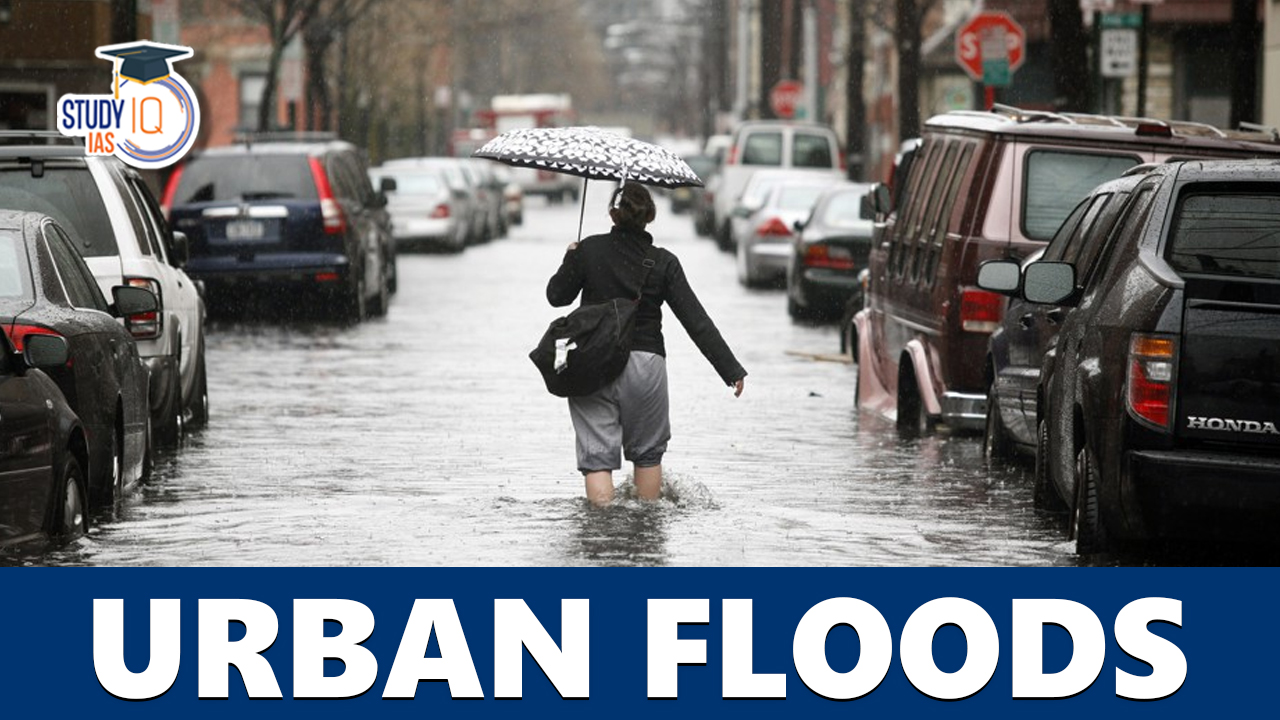Table of Contents
Context: Delhi has been experiencing severe floods due to intense rainfall in the past few days. Experts have cited concerns such as floodplain encroachment and the lack of wetlands.
What is Urban Flooding?
- Urban flooding refers to the inundation of land or built-up areas, particularly in densely populated locations such as cities, due to excessive rainfall that surpasses the capabilities of drainage systems to handle the water.
- Urban flooding is a major problem in many parts of the world and it is the leading cause of global flood losses.
How urban flooding is different from rural flooding?
- Flood intensity: Urban flooding is significantly different from rural flooding as urbanization leads to developed catchments, which increases the flood peaks from 1.8 to 8 times and flood volumes by up to 6 times. Consequently, flooding occurs very quickly due to faster flow times.
- Vulnerability: As urban areas are densely populated; people are more vulnerable to flooding and secondary effect of exposure to infection.
- Economic impact: Urban areas being centers of economic activities have key infrastructure that has a bearing on national and global economy.
Causes of Urban Floods
- Meteorological factors:
- Heavy rainfall: Intense and prolonged rainfall events can overwhelm the capacity of urban drainage systems to handle the volume of water, leading to floods.
- Cyclonic storms and thunderstorms: They can bring heavy rainfall, strong winds, and intense downpours, resulting in rapid runoff leading to urban flooding.
- Climate change: Climate change has resulted in extreme weather events, exacerbating the frequency of heavy rainfall episodes characterized by short durations.
- Hydrological factors:
- Overbank flow channel networks: The presence or absence of well-designed and maintained drainage systems, such as canals, rivers, and stormwater channels, affects the capacity of an area to handle excess water during heavy rainfall.
- High tides in coastal cities: Coastal cities face additional challenges, as high tides can impede the drainage of rainfall water into the ocean or other bodies of water. This can cause water to back up and flood urban areas.
- Anthropogenic Factors:
- Land use changes and urbanization: Extensive urbanization and land use changes, such as replacing natural surfaces with impermeable materials like concrete and asphalt, reduce the land’s ability to absorb rainfall. This increases surface runoff and the risk of urban flooding.
- Example: Chennai Floods 2015 – The rapid and unplanned urbanization in Chennai, particularly the conversion of wetlands and water bodies into built-up areas, played a significant role in exacerbating the flooding.
- Occupation of floodplains and obstruction of flood flows: Building structures in flood-prone areas or obstructing natural watercourses can disrupt the natural flow of water during heavy rainfall events. This can cause water to accumulate and lead to flooding.
- Example: Mumbai Floods 2005 – The flood event in Mumbai was partly attributed to the occupation of floodplains and the obstruction of flood flows due to encroachments and improper land use.
- Urban heat island effect: Urban areas often experience higher temperatures than surrounding rural areas, creating what is known as the urban heat island effect. This can influence weather patterns and increase localized rainfall, which can contribute to urban flooding.
- Dam operations: Sudden releases of water from upstream dams can result in a surge of water downstream, overwhelming urban areas. Conversely, failure to release water from dams during heavy rainfall can cause a backwater effect, where water cannot flow freely, leading to flooding.
- Example: Uttarakhand Floods 2013 – The devastating flood event in Uttarakhand was exacerbated by the sudden release of water from dams located upstream. Heavy rainfall combined with the release of water from dams caused flash floods and landslides, resulting in significant loss of life and infrastructure damage in the region.
- Improper waste disposal: Indiscriminate disposal of solid waste, such as garbage and debris, into urban water drains and channels can clog the drainage system. This obstruction impedes the flow of water during the monsoon season and increases the likelihood of urban flooding.
- Example: Bengaluru Floods 2017 – The improper disposal of solid waste, particularly the clogging of stormwater drains with garbage and debris, contributed to urban flooding in Bengaluru.
- Illegal Mining Activities: Illegal mining of river sand and quartzite for use in building construction deplete the natural bed of the rivers and lakes. It causes soil erosion and reduces the water retention capacity of the waterbody increasing the speed and scale of water flow.
- Land use changes and urbanization: Extensive urbanization and land use changes, such as replacing natural surfaces with impermeable materials like concrete and asphalt, reduce the land’s ability to absorb rainfall. This increases surface runoff and the risk of urban flooding.

Impacts of Urban Flooding
- Loss of Life and Property: Urban flooding poses a direct threat to human life and can result in casualties and injuries. It also leads to damage and destruction of buildings, infrastructure, and personal property.
- Disruption of City Functions: Urban flooding can damage water supply systems, sewerage networks, power transmission lines, communication networks, transportation infrastructure (roads and railways), and other essential services.
- Environmental Impact: The force of floodwaters can uproot trees, destroy vegetation, and lead to soil erosion. It also washes pollutants, debris, and waste into rivers and other water bodies, harming aquatic ecosystems and contributing to water pollution.
- Health Impacts: Urban flooding increases the risk of waterborne diseases and the spread of infections. Contaminated floodwater can carry pathogens, chemicals, and pollutants that pose health hazards to humans and animals.
- Psychological Impacts: loss of shelter, personal belongings, and the trauma of witnessing the destruction and potential loss of lives can lead to long-lasting emotional distress and post-traumatic stress disorder (PTSD).
Urban Flood Risk in India
- There has been an increasing trend of urban flood disasters in India over the past several years whereby major cities in India have been severely affected.
- Recent events of urban floods include Chennai floods of 2015 Mumbai floods of 2017, Guwahati floods of 2010, Bengaluru floods 2017 and Hyderabad floods of 2020.
- There will be a rise in the frequency of floods in India due to rise in temperatures between 2070 and 2100, according to Climate Change and India: A 4×4 Assessment, a report by the Union Ministry of Environment and Forest.
- Regions susceptible to floods, according to the National Disaster Management Authority (NDMA), lie mostly along the Ganga-Brahmaputra river basin, from the northern states of Himachal Pradesh and Punjab, covering Uttar Pradesh and Bihar and stretching to Assam and Arunachal Pradesh in the northeast.
- The coastal states of Odisha and Andhra Pradesh, parts of Telangana and Gujarat also witness yearly floods, NDMA observed.

National Disaster Management (NDMA) Guidelines on Urban Flood Management
In 2010, NDMA had issued guidelines on Urban Flood Management in India:
- Create a National Hydro-meteorological Network.
- The guidelines say that for providing early warning, the Central Water Commission (CWC) should maximize the real-time hydro-meteorological network to cover all urban centres to effectively deal with the problem of urban flooding.
- Use of Doppler Weather Radars to be expanded to cover all urban areas in the country.
- An inventory of the existing stormwater drainage system to be prepared. The inventory will be both watershed-based and ward-based.
- Catchment to be the basis for planning and designing the stormwater drainage systems in all ULBs (Urban Local Bodies).
- All future road and rail bridges in cities crossing drain to be designed such that they do not block the flows resulting in backwater effect.
- Every building in an urban area must have rainwater harvesting as an integral component of the building utility.
- Low-lying areas in cities have to be reserved for parks and other low-impact human activities.
- Encroachments on the drain should attract penal action.
- Pre-monsoon desilting of all major drains to be completed by March 31 each year.
- Urban Flooding has to be dealt as a separate disaster, de-linking it from riverine floods which affect the rural areas.
- Suitable interventions in the drainage system like traps, trash racks can be provided to reduce the amount of solid waste going into the storm sewers.
- Inlets to be provided on the roads to drain water to the roadside drains and these have to be designed based on current national and international practices.
- Concept of Rain Gardens to be incorporated in planning for public parks and on-site stormwater management for larger colonies and sites that are to be developed.
- Flood hazard assessments should be done on the basis of projected future scenarios of intensities and duration of the rainfall and land-use changes.
Way Forward
- Climate-Resilient Infrastructure: Develop climate-resilient infrastructure that can withstand extreme weather events and effectively manage water runoff. This includes incorporating green infrastructure, such as bioswales, permeable pavements, and rooftop gardens, which can absorb and store rainwater.
- Early Warning Systems and Communication: Establish robust early warning systems that utilize advanced technologies to disseminate flood warnings in real-time. This helps residents and authorities to take necessary precautions and evacuate if required.
- Developing Sponge Cities: The idea of a sponge city is to make cities more permeable so as to hold and use the water which falls upon it. The approach aims to enhance the capacity of cities to absorb, store, and utilize rainwater to mitigate flood risks and improve water resource management.
- Urban Drainage Systems: Implement proper watershed management and develop emergency drainage plans. Regular maintenance and cleaning of drains and stormwater channels are essential to ensure smooth water flow and prevent blockages caused by solid waste and debris.
- Conservation of Water Bodies: Protect and restore urban water bodies like lakes, tanks, and ponds, as they play a crucial role in managing urban flooding. These water bodies can act as natural retention basins, reducing stormwater runoff and preventing flooding.
- Role of Science and Technology: This includes the use of predictive precipitation modeling, geospatial frameworks for vulnerability assessments, and innovative tools for analyzing and planning effective flood management strategies.
- Urban planning with nature-based solutions: urban flood management in India continues to focus only on improving grey infrastructure, rescue & relief, instead of building solutions to increase flood resilience. Therefore, urban planning should adopt a hybrid approach of integrated green and grey infrastructure solutions.



 Securities Markets Code Bill 2025: Towar...
Securities Markets Code Bill 2025: Towar...
 Weakly Interacting Massive Particles (WI...
Weakly Interacting Massive Particles (WI...
 India–Oman Trade Deal: CEPA Signed to ...
India–Oman Trade Deal: CEPA Signed to ...

























